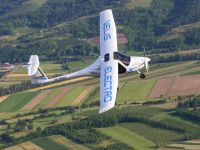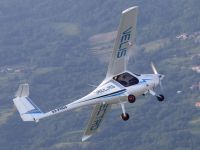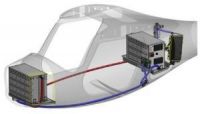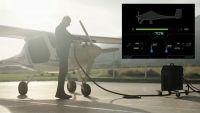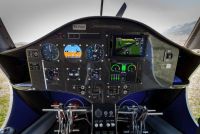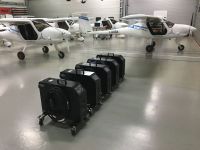VELIS ELECTRO IS FOR YOU BECAUSE YOU ARE LOOKING FOR...
REVOLUTIONARY
- First ever Type Certified electric powered aeroplane, fully approved for pilot training in Day VFR operations
- Game changing ease of operation and intuitive powertrain management
- First to support SAE AE-7D charging plug
SIMPLE USAGE
- Quiet on the inside, quiet on the outside
- Optimized for pilot training as an element of the Velis Training System, complementing the SW 121, but can be enjoyed separately as well.
- Can operate in cold, hot and rain
ELECTRIC FLYING
- Demonstrated levels of safety equivalent or higher than with conventionally powered airplanes, with type certified engine, fault-tolerant and crashworthy battery system
- Built on top of 12 years of experience with electric flight using proven in-house technologies
- Becoming a trendsetter and being different from the others by flying electric!
VELIS ELECTRO: ARRIVING FROM THE FUTURE, EASA TYPE-CERTIFIED NOW
The greenest way of learning to fly!
Velis Electro is world’s first electric powered airplane to receive a Type Certificate (EASA.A.573 TCDS). The two-seater, intended primarily for pilot training, is a game-changing aircraft in terms of technological innovations and cost-efficiency. Velis Electro can be operated commercially and is fully approved for pilot training as well as other operations. With its quietness, Velis Electro can bring flight training much closer to urban areas without adversely affecting communities’ quality of life.
Quiet and clean
Featuring noise levels of only 60 dBa, Velis Electro is considerably quieter than other aeroplanes and produces no combustion gases at all. Its revolutionary powertrain is entirely liquid-cooled, including the batteries, and demonstrated the ability to withstand faults, battery thermal runaway events, and crash loads as part of the certification process. Velis Electro can operate in cold, hot and rain.
Conceived to be a fundamental member of the Velis Training System, the Velis Electro was designed to be simple to operate and maintain, without compromising safety. Employing the Pipistrel’s type certified electric engine, the Velis Electro delivers power instantly and without hesitation – using a simplified user interface in a cockpit that maintains the same look-and-feel of its conventionally powered siblings. The reduced number of moving parts dramatically decreases maintenance costs and the risk of malfunctions is further minimized thanks to its built-in continuous health-monitoring system. This enhanced reliability allows the Velis Electro to have more than double the lifespan of powertrain elements in comparison to the previous generation of electric airplanes.
Safety
As part of the Type Certification, Pipistrel demonstrated that Velis Electro achieves the highest levels of safety, even surpassing those required for conventionally powered aircraft.
Velis Electro is a full-electric derivative of the proven Virus SW 121, which is already type certified by the European Union Aviation Safety Agency (TC No EASA.A.573). It is equipped with a Pipistrel type certified electric engine E-811-268MVLC (TC No. EASA.E.234), developed with partners EMRAX and EMSISO, and Pipistrel’s three-bladed composite fixed pitch propeller P-812-164-F3A.
The 57.6kW liquid cooled electric engine provides power to the aircraft.
The power is delivered by 345 VDC electric system built around a liquid-cooled in-house developed high performance battery system, which includes two Pipistrel PB345V124E-L batteries connected in parallel, installed in a redundant 2-unit arrangement, total nominal capacity 24.8 kWh. Crashworthy, thermal runaway inhibiting, HIRF/EMI tolerant.
One battery pack is located in the nose of the airplane and the second behind the cabin. This ensures redundancy of the power source: in case of battery failure, the malfunctioning battery would get automatically disconnected from the system. A single battery is capable of standalone operation and has enough power capability to support climbing and continuation of flight.
The liquid-cooling system consists of a radiator and two electrically driven pumps installed in series, located behind the rear battery pack. An air inlet for the radiator is located on left side of the fuselage, and the warm air leaves the fuselage at the bottom. Two high power axial fans are installed behind the radiator in order to allow battery cooling during charging. The fans are automatically controlled and monitored by the BMS for seamless operation.
Batteries can be charged via an onboard charging port using a Pipistrel electric charger. The whole operation is overseen by the Main computer, which displays the status of all systems on the Pipistrel EPSI 570C.
The 5.7 inch LCD EPSI 570C cockpit display is main source of information to the pilot about the operational state of the electric propulsion system in the aircraft, using intuitive graphics to display all relevant parameters. EPSI 570C is also used as the gateway for system software updates.
Unlike a start-up procedure of a conventionally powered airplane, the Velis Electro is powered-up by four switches and requires no warm-up time before take-off. This paradigm shift coupled with unprecedented quietness both inside the cockpit as well as from the outside, the Velis Electro truly is a game-changing aircraft to revolutionise your organisation and empower a new generation of aviators.
TECHNICAL DATA PIPISTREL VELIS ELECTRO
| MODEL | VELIS ELECTRO |
|---|---|
| ENGINE | Pipistrel E-811 EASA Type-Certified |
| max power | 57.6 kW MTOP |
| PROPELLER | Pipistrel P-812-164-F3A Certified fixed-pitch composite three-blade, 1.64 m diameter |
DIMENSIONS
| wingspan | 10.71 m (35′ 1″) |
| length | 6.47 m (21′ 3″) |
| height | 1.90 m (6′ 23″) |
| wing area | 9.51 m2 (102 .4 sqft) |
| aspect ratio | 12.04 |
| positive flaps | 0° (0), 8° (+1), 19° (+2) |
| centre of gravity | 24% – 32.4% MAC |
WEIGHTS
| basic empty weight – with batteries | 428 kg (941 lb) |
| max take off weight, MTOW | 600 kg (1,320 lb) |
| payload weight | 172 kg (378 lb) |
PERFORMANCE
| Data published for 600 kg MTOW (1.323 lbs). All speeds in Knots | |
| stall speed with flaps, VS0 | 45 KCAS |
| stall speed without flaps | 51 KCAS |
| cruising speed (at 35 kW) | 90 KCAS |
| maximum horizontal speed at sea level | 98 KCAS |
| never exceed speed, VNE | 108 KCAS |
| max speed with flaps (+2), VFE | 65 KIAS |
| manoeuvring speed | 100 KIAS |
| best climb speed, VY | 75 KIAS |
| max climb rate | 3.3 m/s (647 ft/min) |
| best glide ratio speed | 64 KIAS |
| best glide ratio | 15:1 |
| takeoff run – grass/asphalt | 246/241 m (807/791 ft) |
| takeoff over 50′ obstacle – grass/asphalt | 453/409 m (1,486/1,342 ft) |
| service ceiling | 3,660 m (12,000 ft) |
| endurance | up to 50 minutes (plus VFR reserve) |
| max load factor permitted @ (1.875) | +4g -2g |
| design safety factors & tested | minimum 1.875 |
Note: Data is for ISA sea-level conditions. Pipistrel reserves the right to revise this data sheet whenever occasioned by product improvement, government/authority regulations or other good cause.
Frequently Asked Questions
GENERAL
Where does the Velis name come from?
Velis comes from the ablative case of the Latin word for “sail” (velum, veli) and translates into “moving with sails (unaided)”. Its name reminds you of sailing boats, which, quiet and green, have cruised the seas of the world for centuries. Velis Electro is then the forerunner shaping a new era of aviation.
How is the Velis Electro different from the Alpha Electro?
- The Velis Electro features an entirely liquid-cooled powertrain, including the batteries, which are also of next-generation technology. Thanks to these improvements, the lifespan of the powertrain is double than that of the previous generation of electric aircraft. The motor and the power controller are also improved for robust operation in hot and cold climates.
- The Velis Electro has a 50 kg higher MTOW than the Alpha Electro.
- In the cockpit, the Velis Electro includes an embedded data-logger, and a tactile and aural AOA-based stall warning.
- The aircraft has heavy-duty landing gear and wheel brakes, 15% more energy onboard and its systems have shown resistance to HIRF (direct and indirect effects).
- And finally, the Velis Electro is EASA type certified, which opens the door for commercial operation.
What is the price of a Velis Electro?
For pricing and additional options please contact sales@pipistrel-aircraft.com
TYPE CERTIFICATION
What is a Type Certificate? What is the difference with previous electric aeroplanes?
By issuing a Type Certificate, EASA confirms that the aircraft, intended for serial production, is in compliance with applicable airworthiness requirements established by the European Union air law. It allows the aircraft to be exploited commercially.
Previous electric aircraft have obtained different levels of approvals from national authorities, however, none has been able to demonstrate levels of safety equivalent to standard category aeroplanes or was able to operate commercially.
Will it be certified by the FAA or other non-EASA member states?
We are working to validate the TC for the Velis Electro in other countries as we did with the Virus SW 121. We are also working to create certification paths with the FAA, but at this moment it’s difficult to predict when it will happen. Of course, we will announce it on our website, so please follow our online releases.
Is the Velis Eletro approved for intentional spins?
Pipistrel has other aircraft from the Velis Training System designed for intentional spin and UPRT training.
BATTERY AND CHARGING
Are the batteries prone to fire?
In the scope of the certification process, the batteries went through an extensive series of tests that thoroughly evaluated the integrity of the battery packs and their ability to resist thermal runaway. Special safety features are built into the design to achieve levels of safety according to the stringent DO-311A requirements. The batteries have demonstrated to be crashworthy, resistant to thermal runaway and fault-tolerant.
How fast does the battery charge?
The charging logic was tuned in a compromise between charging time, ambient temperature robustness and battery system lifetime. A normal charging cycle from 35% to 95% SOC (state-of-charge) takes up to 1 hour and 20 minutes. A full charge from 30% to 100%, depending on ambient temperatures and age of battery takes up to 2 hours. Operational experience and technical improvements will allow us to activate charging logic profiles for shorter charging times.
Is there the possibility of plug in/out swappable batteries for quick turn arounds in a flying school?
To maintain superior longevity of the battery, a breakthrough design employing liquid cooling for the batteries was employed, which precludes quick battery swapping. Consider that each of the two batteries weighs approximately 70 kg; quick swapping would necessitate additional ground handling equipment and introduce potential safety hazard associated with battery dropping on the floor. Pipistrel recommends using more Velis Electro aircraft in your fleet to enable quick turn-around times for students and instructors when using the superior SkyCharge line of Pipistrel in-house developed aircraft battery chargers.
What power supply output is required to charge the batteries?
While a single-phase 240 VAC regular wall socket can be used for overnight charges, Pipistrel recommends a three-phase 380 VAC connection, in order to enable quick charging.
What type of connector does the Velis Electro use? Is the charger compatible with electric cars?
The Velis Electro has a DC GB/T 20234 connector. Even if this standard connector is also used on cars, Velis Electro charging is allowed only with a Pipistrel portable charger or a Pipistrel Sky ChargeTM charger. Charging electric aircraft has its specifics which not only require addressing the technical feasibility of electrical power transfer but also matters related to cybersecurity and enhanced levels of safety when compared to automotive-class charging. Pipistrel has recently announced a partnership with GreenMotion, a leader in the vehicle charging industry, to work towards enabling dual-use chargers.
PERFORMANCE
What is the flight endurance of the Velis Electro?
The endurance was designed to cover for typical flight school utilisation for local flying (50 minutes plus reserve) and is a compromise between performance, environmental robustness (flying in hot, flying in cold, charging in hot, charging in cold) and battery system lifetime.
What is the range?
The Velis Electro is designed for local flights to work alongside other aircraft of the Velis Training System, therefore A to B flights are not part of the typical mission. Endurance for training sorties is, therefore, the appropriate parameter to quote.
What is the lifespan of the powertrain components, including batteries?
The TBO (time between overhaul) of the motor is 2000 hours. The initial limitation imposed on the batteries is 500 hours. Pipistrel expects to increase the TBO of the batteries as additional testing and operational experience is accumulated.
ENVIRONMENT
Is the Velis Electro quiet?
Featuring noise levels of only 60 dBa, the Velis Electro is significantly quieter than other aeroplanes both inside and on the outside. This, together with the fact that it produces no combustion gases at all, makes it one of the least polluting aeroplanes.
Can I fly it in cold weather?
Absolutely. Even if the batteries endurance is affected by cold weather, the engine performance is not altered.
Can I fly it in heavy rain?
The Velis Electro is intended for VFR-day operation and has been tested flying in the rain. The rain itself does not present a hazard to the electrical powerplant.
Can the Velis Electro be charged with solar, wind or battery energy?
The charger requires a connection to a single-phase or, ideally, to a three-phase wall socket. Whether the electrical power comes straight from the grid or from other sources (solar, wall-mounted batteries, wind, etc), this does not depend on Pipistrel and should be consulted with the local electrical service provider.
PILOTS AND MAINTENANCE
How does a pilot know all is OK with the aeroplane?
The 5.7 inch LCD EPSI 570C cockpit display is the main source of information to the pilot about the operational state of the electric propulsion system in the aircraft, using intuitive graphics to display all relevant parameters. Enhanced situational awareness is provided by the Crew Alerting System (CAS) and an Annunciator panel.
What pilot licence is needed to fly the Velis Electro?
Velis Electro can be operated by LAPL or PPL holders and instructors following a quick difference training course.
What part of the pilot training can be done on a Velis Electro?
The Velis Electro is ideal to train student pilots towards their LAPL and PPL licences. It is optimized for local flights around the aerodrome, i.e. take-off and landing sorties. The EASA exemption for pilot licencing and training permits the Velis Electro to be utilised in flight training environments and assuring transitions of pilots to and from Velis Electro even before they have obtained a pilot licence.
Does it require any specific maintenance? Do mechanics need additional training?
The Velis Electro is simple to maintain. The powertrain has a much lower number of moving parts and the time between overhaul/replacement of the motor is much longer than that of a piston engine. Batteries are replaceable as an LRU (Line Replaceable Unit), without special skills required related to high voltage or electric powertrains. EASA’s exemption, which was coordinated between French, Swiss, Slovenian CAA’s and Pipistrel, sets forth requirements for Part-66 licenced mechanics, which include a difference training course specific to Velis Electro. Battery overhauls will be initially handled by Pipistrel alone.
Who can perform the annual inspection for renewal of ARC?
Annual inspection for ARC (Airworthiness Review Certificate) renewal can be performed by any National Aviation Authority (NAA) or Part-145 organisation with this privilege, with a Part-66 mechanic that has received the type-specific training at Pipistrel.
ABOUT PIPISTREL AND OTHER QUESTIONS
What is the Velis Training System?
It is a line of products forming an integrated flight training solution, conceived especially for flight schools, included but not limited to Pipistrel Academy, VR Simulators and several aircraft options optimised for pilot training. More details on this will be unveiled soon.
What are the other electric aircraft Pipistrel developed so far?
In chronological order: Taurus Electro, Taurus G4, Taurus Electro G2, WATTsUP, Alpha Electro, HY4, Panthera Hybrid, Velis Electro, Alpha Electro LC.
What are miniliners/microfeeders?
It is a new approach in the aerial mobility market that will be enabled by advanced propulsion technologies such as hydrogen fuel cells, electricity, etc. A microfeeder is a zero-emission commuter-class aeroplane, capable of connecting smaller airports close to communities with larger hubs, whereas a miniliner connects smaller airports between themselves, without compromising the quality of life due to low noise and zero-emission operation, but dramatically shortening travel times inside the European Union. Pipistrel is collaborating with renowned European universities in the development of a disruptive 19‑seater. We will provide more details of this in the future. More information about this project is available here: https://www.pipistrel-aircraft.com/unifier19-2/ and https://www.unifier19.eu/








